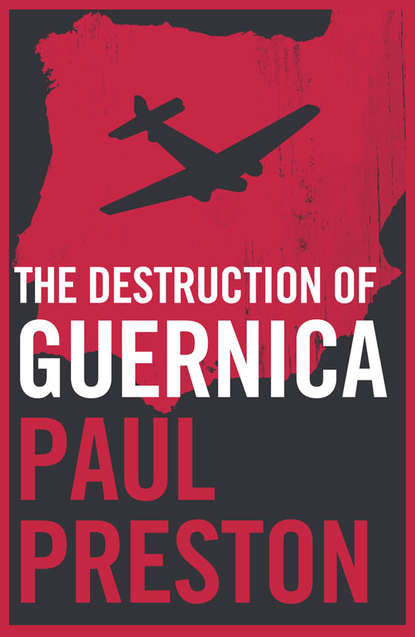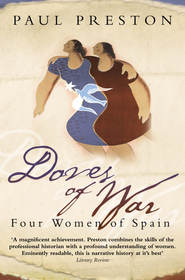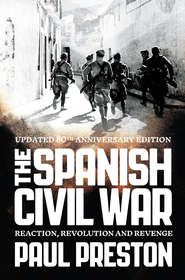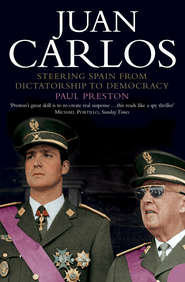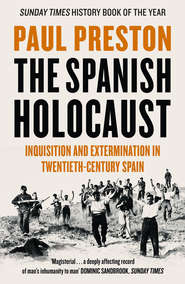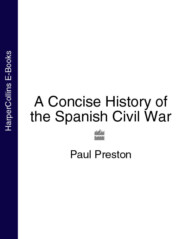По всем вопросам обращайтесь на: info@litportal.ru
(©) 2003-2024.
✖
The Destruction of Guernica
Настройки чтения
Размер шрифта
Высота строк
Поля
The Destruction of Guernica
Paul Preston
A powerful and searing account of the destruction of Guernica by Hitler’s Condor League in April 1937 written by Paul Preston – foremost historian of 20th century Spain and best-selling and critically acclaimed author of The Spanish Holocaust.The destruction of Guernica seventy-five years ago, on 26 April 1937, is burned into European consciousness as the first time aerial bombardment wiped out an undefended civilian target in Europe. The events of that day have provoked more savage polemic than any single act of war since. With the help of Picasso’s masterpiece, Guernica is now remembered as the place where the new and horrific warfare came of age.It was market day in the sleepy Basque town. Guernica was packed with farmers and traders flocking to sell their wares, to catch-up on the news and purchase goods, little-expecting the devastation that was about to fall upon them. Just before 5pm, planes from Hitler’s Condor League began their assault, bombing and shelling the town for over three hours, swooping low to machine-gun civilians as they fled.In this book, Paul Preston – the foremost historian of 20th century Spain – tells the story of this tragedy and examines not only the tactics and motivations of Hitler’s Condor Legion, their subordination to Franco’s orders; the obsessive cruelty of Franco’s commander in the north, General Emilio Mola, and the purpose of the attack on Guernica within Franco’s war effort; but also the vital part played by journalists like George Steer whose eye-witness reports for The Times from Guernica roundly disproved Franco’s mendacious denials of involvement, focused the eyes of the world on the tragedy, and helped persuade the British government to allow over 4,000 Basque child refugees into Britain.Published to tie-in with the 75th anniversary of the bombing, this book cuts through the lies, manipulative comments and misunderstandings that have surrounded this tragedy to give an authoritative, deeply moving account of what happened that day in Guernica.
THE DESTRUCTION OF GUERNICA
REVISED EDITION
Paul Preston
Copyright
William Collins
An imprint of HarperCollinsPublishers
1 London Bridge Street
London SE1 9GF
WilliamCollinsBooks.com (http://WilliamCollinsBooks.com)
This ebook first published in Great Britain in 2012 by Harper Press
Revised edition published by William Collins in 2017
Copyright © Paul Preston, 2012, 2017
A catalogue record for this book is available from the British Library
All rights reserved under International Copyright Conventions. By payment of the required fees, you have been granted the non-exclusive, non-transferable right to access and read the text of this e-book on-screen. No part of this text may be reproduced, transmitted, downloaded, decompiled, reverse engineered, or stored in or introduced into any information storage and retrieval system, in any form or by any means, whether electronic or mechanical, now known or hereinafter invented, without the express written permission of HarperCollins e-books.
Ebook Edition © March 2017 ISBN: 9780007491391
Version: 2017-03-20
Contents
Cover (#uc10f71f5-6090-5686-b3d9-4add487de1bc)
Title Page (#u027c8054-6872-5281-bddb-e22aee0f6a4a)
Copyright (#u91881c44-e172-5992-89be-80be1eb853fc)
The Destruction of Guernica (#ua58e4637-6392-5ec6-b06d-bd19cfdc5a0b)
Notes (#litres_trial_promo)
Bibliography (#litres_trial_promo)
About the Author (#litres_trial_promo)
About the Publisher (#litres_trial_promo)
The Destruction of Guernica
On 19 July 1936, shortly after his declaration of martial law in Pamplona, Emilio Mola called a meeting of the mayors of the province of Navarre. What he told them would characterise his subsequent treatment of the Basque Country. He said: ‘It is necessary to spread terror. We have to create the impression of mastery, eliminating without scruples or hesitation all those who do not think as we do. There can be no cowardice. If we vacillate one moment and fail to proceed with the greatest determination, we will not win. Anyone who helps or hides a communist or a supporter of the Popular Front will be shot.’
What this meant for the Basques was soon revealed by an early precursor of what was to happen to Durango and Guernica in the spring of 1937. On 22 July, two aircraft from Vitoria bombed the village square of Otxandio in the south of Vizcaya, killing more than sixty people of whom at least twenty-four were children and mutilating a further eighty. In justification, the rebel command in Vitoria announced that ‘our aircraft have struck a heavy blow against a group of rebels gathered in the rearguard at Otxandio’.
Otxandio is the Basque name of the village called Ochandiano in Spanish.
Because of his early reverses in the sierra north of Madrid, Mola’s first major campaign against the Basque Country did not begin until after the arrival of German and Italian aid in early August which enabled him to launch an attack on the province of Guipúzcoa and Franco to begin the march on Madrid. Already on 23 July, Carlist troops from Navarra had entered the southern part of Guipúzcoa through Cegama and Segura. Although they encountered no resistance, in Cegama and Segura, they sacked the headquarters of Republican parties and the Batzoki (offices) of the Partido Nacionalista Vasco (Basque Nationalist Party). Now, in early August, Mola began a campaign to capture Irún and the provincial capital San Sebastian and cut off Guipúzcoa from the French border. Irún and Fuenterrabía were being shelled from the sea and attacked daily by German and Italian bombers. The British (born in South Africa) correspondent George Steer noted that the rebels had dropped pamphlets threatening to deal with the population as they had dealt with those in Badajoz. The use of pamphlets describing earlier atrocities as a threat of what would happen if surrender were not immediate would happen again eight months later when the experience of Guernica would be used as a threat against Bilbao. San Sebastián was also heavily shelled from the sea. Irún’s poorly armed and untrained militia defenders fought bravely but were overwhelmed on 3 September. Thousands of panic-stricken refugees fled across the international bridge to France. The last defenders, largely anarchists enraged by their lack of ammunition, shot some rightist prisoners in Fuenterrabía and set parts of Irún on fire.
Rebel troops and Carlists occupied San Sebastián on Sunday 13 September and by the end of the month, virtually all of Guipúzcoa was in Mola’s hands.
A substantial number of the city’s 80,000 inhabitants had fled either westward towards Vizcaya or else by boat to France. Nevertheless, the number of executions in San Sebastián would be the highest carried out by the rebels in any Basque city. Mass detentions began immediately, beginning with the wounded Republicans who, given the seriousness of their condition, could not be evacuated from the Hospital Militar. Soon the prisons of Ondarreta and Zapatari, the offices of the Falange in the centre of the city, the San José hospice and the Kursaal cinema were all bursting to the seams with detainees.
Among the hundreds of executions that took place in Guipúzcoa, the most notorious were those of thirteen Basque priests, which were carried out at the behest of the Carlists. In total, the rebels murdered at least sixteen priests in the entire Basque region and imprisoned and tortured many more. Father Alberto Onaindía, whose brother was one of the victims, said prophetically, ‘If this was how the army behaved with the Basque clergy, what would it be like for civilians!’ The testimony of Father Onaindía (a friend of the Lehendakari or President José María Aguirre) would be crucial in dismantling the lies later propagated by the rebels about the bombing of Guernica.
Even before the fall of San Sebastián, Mola had initiated secret negotiations with the Partido Nacionalista Vasco (PNV). Mola hoped for a peaceful surrender of Vizcaya in return for a promise not to destroy the provincial capital Bilbao and a guarantee of no subsequent repression. In the light of what had happened after the captures of Irún and San Sebastián, the PNV leadership had no reason to believe Mola’s promises. In the course of the negotiations, appeals were made to Mola not to bomb Bilbao on the grounds that to do so would provoke reprisals against the two and a half thousand imprisoned rightists in the city.
On 25 and 26 September, major bombing raids on Bilbao caused dozens of deaths and mutilations of women and children which, as predicted, provoked an outburst of rage from the starving population. Two prison ships were assaulted and sixty rightist detainees murdered.
Rebel hostility to the Basque Country intensified after the concession of regional autonomy by Madrid on 1 October and the formation of a Basque government six days later. The newly elected President of the Basque government, José Antonio de Aguirre y Lecube, and his cabinet were sworn in at a ceremony before the Tree of Guernica, the symbol of Basque nationhood. In his speech Aguirre declared that ‘The tradition of our elders was once again reborn in us, and the sacred Tree that in Guernica grows, was no longer a relic, but became once again the living symbol of our history.’
Sporadic bombing raids continued on Bilbao but nothing had prepared the city for the scale of another attack on 4 January. In an even more ferocious incursion into the city’s four prisons, 224 rightists were killed including several priests, most Carlists but some Basque Nationalists.
As long as the siege of the capital was the principal rebel preoccupation, the Basque front remained static until late March 1937. However, the Republican victory at Guadalajara on 20 March 1937 finally undermined Franco’s belief that he could win the war at Madrid and imposed upon him a momentous strategic volte-face. The lesson to be drawn from contrasting the easy victory at Málaga in early February with the immense cost of the battles around Madrid at Jarama and Guadalajara was clear. The Republic was concentrating its best-trained and equipped troops in the centre of Spain and leaving other fronts relatively neglected. Against the Republican army of the Centre, the military rebels were achieving only small gains at the cost of massive bloodshed while against the militias of the periphery, substantial triumphs could come relatively cheaply. Thus, there was a case for desisting from the obsessive concentration on Madrid and destroying the Republic by instalments elsewhere. This was the view of Colonel Juan Vigón Suerodiaz, chief of Mola’s general staff, who argued for priority to be given to operations in the north so that the rebel cause might be strengthened by the seizure of the coal, iron and steel reserves and the armaments factories of the Basque provinces.
Franco initially remained obsessed with Madrid. The commander of the Condor Legion, General Hugo Sperrle, put forward similar arguments with greater insistence. It took the news of the defeat at Guadalajara to change Franco’s thinking, and for him to succumb to the pressure from Sperrle and Vigón and accept that the defeat of the Republic must be sought somewhere other than the outskirts of Madrid. Sperrle persuaded him that resistance in the north would be slight, with promises about the likely impact of concerted airborne ground attacks by the Condor Legion. On 22 March, the Generalísimo presented Kindelán with a sketchy outline of his immediate plans for a huge new force to be massed to attack and take Bilbao. On 23 March, he summoned Mola to Salamanca and gave him specific orders for the assault on Bilbao which derived from Vigón’s suggestions and Sperrle’s proposals.
The operational details were hammered out at meetings held on 24 and 26 March involving General Alfredo Kindelán, as head of Franco’s air force, General José Solchaga and General José López Pinto as field commanders, Vigón as Mola’s chief of staff and Colonel Wolfram von Richthofen, the Condor Legion’s chief of staff. Richthofen explained to his Spanish counterparts the novel strategy of ‘close air support’, using aircraft for sustained ground attack to smash the morale of opposing troops. Accordingly, arrangements were made at these meetings for continuous and rapid liaison between the headquarters of the Spanish ground forces and the Condor Legion. Two hours before any attack, the air force commanders would inform the ground headquarters in order for the necessary coordination to take place. It was also agreed at these meetings that attacks would proceed ‘without taking into account the civilian population’.
Mola gathered a large army consisting of African Army units, of the Carlist militias or requetés now fully militarised as the Navarrese Brigades and of mixed Spanish-Italian brigades. It was backed by the air support of the small but well-equipped Condor Legion and of units of the Italian Aviazione Legionaria under Richthofen’s command.
After Guadalajara, the Germans were keen to show their superiority over the Italians and to practise and develop their techniques of ground attack from the air. In this context, the relationships between Mola and Sperrle and between their chiefs of staff, Vigón and von Richthofen, were constant and close if not exactly cordial. The German government had made it clear in late October 1936 that the commander of the Condor Legion would be solely responsible to Franco. Sperrle was meticulous about observing that hierarchy and, in consequence, enjoyed generally good relations with Franco.
In practice, however, the need to integrate joint air/ground operations on an hour-by-hour basis rendered liaison with Salamanca impracticable. So, content with Sperrle’s deferential manner, Franco allowed him a free hand to liaise directly with Mola and Vigón, except on major issues. Franco was delighted to be able to consider the crack Condor Legion as part of his forces and to sit back and take the credit for its achievements. In the field, Mola and Vigón were also happy to accept the help and advice of Sperrle and Richthofen and the consequence was that, with Franco’s conscious acquiescence, the Germans had the decisive voice in the campaign. Sperrle wrote in 1939, ‘All suggestions made by the Condor Legion for the conduct of the war were accepted gratefully and followed.’ While the advance was being planned, von Richthofen wrote in his diary on 24 March, ‘we are practically in charge of the entire business without any of the responsibility’ and, on 28 March, ‘I am an omnipotent and effective commander (Feldherr) … and I have established effective ground/air command.’
On 31 March, Mola arrived in Vitoria to put the final touches to the offensive that was to be launched on the following day. He began by deploying the weapon of mass fear which had been so effective for Franco in the advance on Madrid of the African columns. He issued a proclamation that was both broadcast and printed in a leaflet dropped on the main towns. It contained the following threat: ‘If your submission is not immediate, I will raze Vizcaya to the ground, beginning with the industries of war. I have ample means to do so.’
In a similar spirit of crushing enemy morale, he ordered the execution of sixteen prisoners in Vitoria. The fact that among them were several popular local figures including the Alcalde, Teodoro González de Zárate, provoked protests from the local right.
This act of gratuitous violence was followed by a massive four-day artillery and aircraft bombardment of eastern Vizcaya in which the small picturesque country town of Durango was destroyed by two bombing attacks carried out by four bombers and nine fighters of the Italian Aviazione Legionaria. Unlike Guernica, after the bombing, Durango remained under the jurisdiction of the Basque Government until 28 April. This permitted an investigation to identify the victims. As a result, the government published the figure of 258 civilians, 127 died during the bombing and at least a further 131 who died shortly after as a consequence of their wounds. Among the dead were fourteen nuns and two priests. Subsequent exhaustive research by Jon Irazabal Agirre reached the figure of 336 dead, of whom 276 could be identified and a further 60 who could not. As was later to be the case with the more notorious bombing of Guernica, Salamanca denied that the raid on Durango had taken place and attributed the damage to the Basques themselves.
Rebel progress in the first three days of Mola’s campaign was so slow that Sperrle sent a report to Kindelán in which he complained that ‘if the troops do not advance faster, we will not enter Bilbao’. Sperrle believed that Franco had retained too much artillery and infantry on the Madrid front.
On 2 April, Sperrle and Richthofen complained about this to Mola. Equally anxious to speed things up, Mola suggested to Sperrle that the industries of Bilbao be destroyed. When the German commander asked why it made any sense to destroy industries which it was hoped to capture shortly after, Mola replied: ‘Spain is totally dominated by the industrial centres of Bilbao and Barcelona. Under such a domination, Spain can never be cleaned up. Spain has got too many industries which only produce discontent’, adding that ‘if half of Spain’s factories were destroyed by German bombers, the subsequent reconstruction of Spain would be greatly facilitated’. In response to the notion that Spain’s health required the elimination of the industrial proletariat, Sperrle pointed out that the German air forces in Spain would attack factories only when Franco gave them specific orders to do so. According to Richthofen, Mola told Vigón to issue the order. Richthofen said that it had to come from a higher authority. Mola then signed orders himself for attacks on Basque industrial targets. Richthofen agreed to bomb the explosives factory at Galdácano on the ‘next free day’. Sperrle and Richthofen, however, informed Franco and awaited his permission to carry out Mola’s orders. Sperrle even offered to put an aircraft at Franco’s disposal for him to come to Vitoria to discuss the situation.
Paul Preston
A powerful and searing account of the destruction of Guernica by Hitler’s Condor League in April 1937 written by Paul Preston – foremost historian of 20th century Spain and best-selling and critically acclaimed author of The Spanish Holocaust.The destruction of Guernica seventy-five years ago, on 26 April 1937, is burned into European consciousness as the first time aerial bombardment wiped out an undefended civilian target in Europe. The events of that day have provoked more savage polemic than any single act of war since. With the help of Picasso’s masterpiece, Guernica is now remembered as the place where the new and horrific warfare came of age.It was market day in the sleepy Basque town. Guernica was packed with farmers and traders flocking to sell their wares, to catch-up on the news and purchase goods, little-expecting the devastation that was about to fall upon them. Just before 5pm, planes from Hitler’s Condor League began their assault, bombing and shelling the town for over three hours, swooping low to machine-gun civilians as they fled.In this book, Paul Preston – the foremost historian of 20th century Spain – tells the story of this tragedy and examines not only the tactics and motivations of Hitler’s Condor Legion, their subordination to Franco’s orders; the obsessive cruelty of Franco’s commander in the north, General Emilio Mola, and the purpose of the attack on Guernica within Franco’s war effort; but also the vital part played by journalists like George Steer whose eye-witness reports for The Times from Guernica roundly disproved Franco’s mendacious denials of involvement, focused the eyes of the world on the tragedy, and helped persuade the British government to allow over 4,000 Basque child refugees into Britain.Published to tie-in with the 75th anniversary of the bombing, this book cuts through the lies, manipulative comments and misunderstandings that have surrounded this tragedy to give an authoritative, deeply moving account of what happened that day in Guernica.
THE DESTRUCTION OF GUERNICA
REVISED EDITION
Paul Preston
Copyright
William Collins
An imprint of HarperCollinsPublishers
1 London Bridge Street
London SE1 9GF
WilliamCollinsBooks.com (http://WilliamCollinsBooks.com)
This ebook first published in Great Britain in 2012 by Harper Press
Revised edition published by William Collins in 2017
Copyright © Paul Preston, 2012, 2017
A catalogue record for this book is available from the British Library
All rights reserved under International Copyright Conventions. By payment of the required fees, you have been granted the non-exclusive, non-transferable right to access and read the text of this e-book on-screen. No part of this text may be reproduced, transmitted, downloaded, decompiled, reverse engineered, or stored in or introduced into any information storage and retrieval system, in any form or by any means, whether electronic or mechanical, now known or hereinafter invented, without the express written permission of HarperCollins e-books.
Ebook Edition © March 2017 ISBN: 9780007491391
Version: 2017-03-20
Contents
Cover (#uc10f71f5-6090-5686-b3d9-4add487de1bc)
Title Page (#u027c8054-6872-5281-bddb-e22aee0f6a4a)
Copyright (#u91881c44-e172-5992-89be-80be1eb853fc)
The Destruction of Guernica (#ua58e4637-6392-5ec6-b06d-bd19cfdc5a0b)
Notes (#litres_trial_promo)
Bibliography (#litres_trial_promo)
About the Author (#litres_trial_promo)
About the Publisher (#litres_trial_promo)
The Destruction of Guernica
On 19 July 1936, shortly after his declaration of martial law in Pamplona, Emilio Mola called a meeting of the mayors of the province of Navarre. What he told them would characterise his subsequent treatment of the Basque Country. He said: ‘It is necessary to spread terror. We have to create the impression of mastery, eliminating without scruples or hesitation all those who do not think as we do. There can be no cowardice. If we vacillate one moment and fail to proceed with the greatest determination, we will not win. Anyone who helps or hides a communist or a supporter of the Popular Front will be shot.’
What this meant for the Basques was soon revealed by an early precursor of what was to happen to Durango and Guernica in the spring of 1937. On 22 July, two aircraft from Vitoria bombed the village square of Otxandio in the south of Vizcaya, killing more than sixty people of whom at least twenty-four were children and mutilating a further eighty. In justification, the rebel command in Vitoria announced that ‘our aircraft have struck a heavy blow against a group of rebels gathered in the rearguard at Otxandio’.
Otxandio is the Basque name of the village called Ochandiano in Spanish.
Because of his early reverses in the sierra north of Madrid, Mola’s first major campaign against the Basque Country did not begin until after the arrival of German and Italian aid in early August which enabled him to launch an attack on the province of Guipúzcoa and Franco to begin the march on Madrid. Already on 23 July, Carlist troops from Navarra had entered the southern part of Guipúzcoa through Cegama and Segura. Although they encountered no resistance, in Cegama and Segura, they sacked the headquarters of Republican parties and the Batzoki (offices) of the Partido Nacionalista Vasco (Basque Nationalist Party). Now, in early August, Mola began a campaign to capture Irún and the provincial capital San Sebastian and cut off Guipúzcoa from the French border. Irún and Fuenterrabía were being shelled from the sea and attacked daily by German and Italian bombers. The British (born in South Africa) correspondent George Steer noted that the rebels had dropped pamphlets threatening to deal with the population as they had dealt with those in Badajoz. The use of pamphlets describing earlier atrocities as a threat of what would happen if surrender were not immediate would happen again eight months later when the experience of Guernica would be used as a threat against Bilbao. San Sebastián was also heavily shelled from the sea. Irún’s poorly armed and untrained militia defenders fought bravely but were overwhelmed on 3 September. Thousands of panic-stricken refugees fled across the international bridge to France. The last defenders, largely anarchists enraged by their lack of ammunition, shot some rightist prisoners in Fuenterrabía and set parts of Irún on fire.
Rebel troops and Carlists occupied San Sebastián on Sunday 13 September and by the end of the month, virtually all of Guipúzcoa was in Mola’s hands.
A substantial number of the city’s 80,000 inhabitants had fled either westward towards Vizcaya or else by boat to France. Nevertheless, the number of executions in San Sebastián would be the highest carried out by the rebels in any Basque city. Mass detentions began immediately, beginning with the wounded Republicans who, given the seriousness of their condition, could not be evacuated from the Hospital Militar. Soon the prisons of Ondarreta and Zapatari, the offices of the Falange in the centre of the city, the San José hospice and the Kursaal cinema were all bursting to the seams with detainees.
Among the hundreds of executions that took place in Guipúzcoa, the most notorious were those of thirteen Basque priests, which were carried out at the behest of the Carlists. In total, the rebels murdered at least sixteen priests in the entire Basque region and imprisoned and tortured many more. Father Alberto Onaindía, whose brother was one of the victims, said prophetically, ‘If this was how the army behaved with the Basque clergy, what would it be like for civilians!’ The testimony of Father Onaindía (a friend of the Lehendakari or President José María Aguirre) would be crucial in dismantling the lies later propagated by the rebels about the bombing of Guernica.
Even before the fall of San Sebastián, Mola had initiated secret negotiations with the Partido Nacionalista Vasco (PNV). Mola hoped for a peaceful surrender of Vizcaya in return for a promise not to destroy the provincial capital Bilbao and a guarantee of no subsequent repression. In the light of what had happened after the captures of Irún and San Sebastián, the PNV leadership had no reason to believe Mola’s promises. In the course of the negotiations, appeals were made to Mola not to bomb Bilbao on the grounds that to do so would provoke reprisals against the two and a half thousand imprisoned rightists in the city.
On 25 and 26 September, major bombing raids on Bilbao caused dozens of deaths and mutilations of women and children which, as predicted, provoked an outburst of rage from the starving population. Two prison ships were assaulted and sixty rightist detainees murdered.
Rebel hostility to the Basque Country intensified after the concession of regional autonomy by Madrid on 1 October and the formation of a Basque government six days later. The newly elected President of the Basque government, José Antonio de Aguirre y Lecube, and his cabinet were sworn in at a ceremony before the Tree of Guernica, the symbol of Basque nationhood. In his speech Aguirre declared that ‘The tradition of our elders was once again reborn in us, and the sacred Tree that in Guernica grows, was no longer a relic, but became once again the living symbol of our history.’
Sporadic bombing raids continued on Bilbao but nothing had prepared the city for the scale of another attack on 4 January. In an even more ferocious incursion into the city’s four prisons, 224 rightists were killed including several priests, most Carlists but some Basque Nationalists.
As long as the siege of the capital was the principal rebel preoccupation, the Basque front remained static until late March 1937. However, the Republican victory at Guadalajara on 20 March 1937 finally undermined Franco’s belief that he could win the war at Madrid and imposed upon him a momentous strategic volte-face. The lesson to be drawn from contrasting the easy victory at Málaga in early February with the immense cost of the battles around Madrid at Jarama and Guadalajara was clear. The Republic was concentrating its best-trained and equipped troops in the centre of Spain and leaving other fronts relatively neglected. Against the Republican army of the Centre, the military rebels were achieving only small gains at the cost of massive bloodshed while against the militias of the periphery, substantial triumphs could come relatively cheaply. Thus, there was a case for desisting from the obsessive concentration on Madrid and destroying the Republic by instalments elsewhere. This was the view of Colonel Juan Vigón Suerodiaz, chief of Mola’s general staff, who argued for priority to be given to operations in the north so that the rebel cause might be strengthened by the seizure of the coal, iron and steel reserves and the armaments factories of the Basque provinces.
Franco initially remained obsessed with Madrid. The commander of the Condor Legion, General Hugo Sperrle, put forward similar arguments with greater insistence. It took the news of the defeat at Guadalajara to change Franco’s thinking, and for him to succumb to the pressure from Sperrle and Vigón and accept that the defeat of the Republic must be sought somewhere other than the outskirts of Madrid. Sperrle persuaded him that resistance in the north would be slight, with promises about the likely impact of concerted airborne ground attacks by the Condor Legion. On 22 March, the Generalísimo presented Kindelán with a sketchy outline of his immediate plans for a huge new force to be massed to attack and take Bilbao. On 23 March, he summoned Mola to Salamanca and gave him specific orders for the assault on Bilbao which derived from Vigón’s suggestions and Sperrle’s proposals.
The operational details were hammered out at meetings held on 24 and 26 March involving General Alfredo Kindelán, as head of Franco’s air force, General José Solchaga and General José López Pinto as field commanders, Vigón as Mola’s chief of staff and Colonel Wolfram von Richthofen, the Condor Legion’s chief of staff. Richthofen explained to his Spanish counterparts the novel strategy of ‘close air support’, using aircraft for sustained ground attack to smash the morale of opposing troops. Accordingly, arrangements were made at these meetings for continuous and rapid liaison between the headquarters of the Spanish ground forces and the Condor Legion. Two hours before any attack, the air force commanders would inform the ground headquarters in order for the necessary coordination to take place. It was also agreed at these meetings that attacks would proceed ‘without taking into account the civilian population’.
Mola gathered a large army consisting of African Army units, of the Carlist militias or requetés now fully militarised as the Navarrese Brigades and of mixed Spanish-Italian brigades. It was backed by the air support of the small but well-equipped Condor Legion and of units of the Italian Aviazione Legionaria under Richthofen’s command.
After Guadalajara, the Germans were keen to show their superiority over the Italians and to practise and develop their techniques of ground attack from the air. In this context, the relationships between Mola and Sperrle and between their chiefs of staff, Vigón and von Richthofen, were constant and close if not exactly cordial. The German government had made it clear in late October 1936 that the commander of the Condor Legion would be solely responsible to Franco. Sperrle was meticulous about observing that hierarchy and, in consequence, enjoyed generally good relations with Franco.
In practice, however, the need to integrate joint air/ground operations on an hour-by-hour basis rendered liaison with Salamanca impracticable. So, content with Sperrle’s deferential manner, Franco allowed him a free hand to liaise directly with Mola and Vigón, except on major issues. Franco was delighted to be able to consider the crack Condor Legion as part of his forces and to sit back and take the credit for its achievements. In the field, Mola and Vigón were also happy to accept the help and advice of Sperrle and Richthofen and the consequence was that, with Franco’s conscious acquiescence, the Germans had the decisive voice in the campaign. Sperrle wrote in 1939, ‘All suggestions made by the Condor Legion for the conduct of the war were accepted gratefully and followed.’ While the advance was being planned, von Richthofen wrote in his diary on 24 March, ‘we are practically in charge of the entire business without any of the responsibility’ and, on 28 March, ‘I am an omnipotent and effective commander (Feldherr) … and I have established effective ground/air command.’
On 31 March, Mola arrived in Vitoria to put the final touches to the offensive that was to be launched on the following day. He began by deploying the weapon of mass fear which had been so effective for Franco in the advance on Madrid of the African columns. He issued a proclamation that was both broadcast and printed in a leaflet dropped on the main towns. It contained the following threat: ‘If your submission is not immediate, I will raze Vizcaya to the ground, beginning with the industries of war. I have ample means to do so.’
In a similar spirit of crushing enemy morale, he ordered the execution of sixteen prisoners in Vitoria. The fact that among them were several popular local figures including the Alcalde, Teodoro González de Zárate, provoked protests from the local right.
This act of gratuitous violence was followed by a massive four-day artillery and aircraft bombardment of eastern Vizcaya in which the small picturesque country town of Durango was destroyed by two bombing attacks carried out by four bombers and nine fighters of the Italian Aviazione Legionaria. Unlike Guernica, after the bombing, Durango remained under the jurisdiction of the Basque Government until 28 April. This permitted an investigation to identify the victims. As a result, the government published the figure of 258 civilians, 127 died during the bombing and at least a further 131 who died shortly after as a consequence of their wounds. Among the dead were fourteen nuns and two priests. Subsequent exhaustive research by Jon Irazabal Agirre reached the figure of 336 dead, of whom 276 could be identified and a further 60 who could not. As was later to be the case with the more notorious bombing of Guernica, Salamanca denied that the raid on Durango had taken place and attributed the damage to the Basques themselves.
Rebel progress in the first three days of Mola’s campaign was so slow that Sperrle sent a report to Kindelán in which he complained that ‘if the troops do not advance faster, we will not enter Bilbao’. Sperrle believed that Franco had retained too much artillery and infantry on the Madrid front.
On 2 April, Sperrle and Richthofen complained about this to Mola. Equally anxious to speed things up, Mola suggested to Sperrle that the industries of Bilbao be destroyed. When the German commander asked why it made any sense to destroy industries which it was hoped to capture shortly after, Mola replied: ‘Spain is totally dominated by the industrial centres of Bilbao and Barcelona. Under such a domination, Spain can never be cleaned up. Spain has got too many industries which only produce discontent’, adding that ‘if half of Spain’s factories were destroyed by German bombers, the subsequent reconstruction of Spain would be greatly facilitated’. In response to the notion that Spain’s health required the elimination of the industrial proletariat, Sperrle pointed out that the German air forces in Spain would attack factories only when Franco gave them specific orders to do so. According to Richthofen, Mola told Vigón to issue the order. Richthofen said that it had to come from a higher authority. Mola then signed orders himself for attacks on Basque industrial targets. Richthofen agreed to bomb the explosives factory at Galdácano on the ‘next free day’. Sperrle and Richthofen, however, informed Franco and awaited his permission to carry out Mola’s orders. Sperrle even offered to put an aircraft at Franco’s disposal for him to come to Vitoria to discuss the situation.





